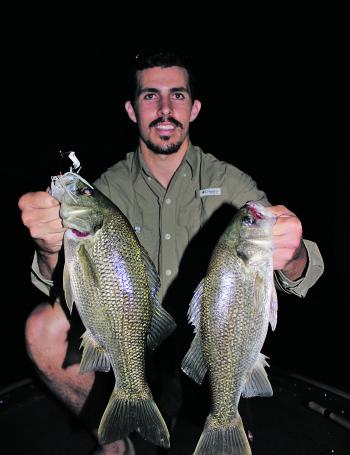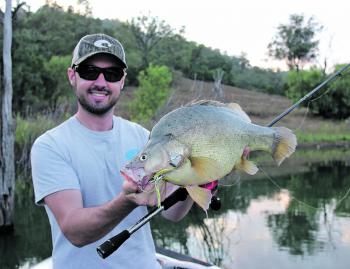Autumn is finally upon us after some hot summer roastings. It’s been one of the hottest on record and the dam levels have suffered. March’s weather should be fairly predictable, with consecutive glassed out days and hopefully some steady rain coming.
Unfortunately, those hot days can still hang around until the end of the month. The surface water temperatures will still be warm in the local lakes, so most of the fish will be deep. Lure fishing around the full moon is renowned for being tough at this time of year, but can be quite productive for the bait fishers.
The Lake St Clair weed beds will have hopefully held up from the dropping water levels and hot temperatures. This weed will still hold plenty of fish, but getting these fish to bite is another thing. Low light is always the key when targeting shallow water fish. Early morning or late evening and overcast days will be the best.
They will be keyed onto the smaller baitfish in the lake. Small plastics, jerkbaits, crankbaits and topwater will be the key producers. Once that sun gets up, its time to move slighter deeper. Outside the weed beds in 15-30ft, there should be plenty of fish. Generally smaller than their weed dwelling siblings, there will be enough to keep you interested. A slow rolled grub cast parallel to the weed works well and fools the larger of the fish in the schools. Mix it up with a hopped 1/4oz, this duel approach can be deadly.
If you’re after numbers, a jig spinner or beetle spin rigged on a blade, or even a lipless crankbait works wonders at this time of year, producing sheer numbers of fish. Concentrating on bottom contact and working your lure through the scattered fish is key to catching them.
If you are having no success on these shallower fish, try moving out into 40ft and deeper. There should be scattered fish out here that will eat a vertical slowed rolled grub. Tree hopping is a good way of locating deep fish. The limited amount of trees in St Clair can concentrate the fish around them. The tree gives you a visual target to go towards without having to spend time sounding around for fish. Moving from tree to tree and dropping your grub down 5-6 times around the whole tree will let you know if any fish are relating to timber. Golden perch love hanging off these submerged trees and this is also a deadly way of catching them as well as bass.
Lake Glenbawn’s lure fishing can be hot and cold this month. There will be still a prominent deep bite going on. The main food source in the Hunter Valley’s lakes are small baitfish, whether it’s smelt, gudgeons or minnows. This is why a plastic is such a great lure for targeting these fish. Matching the hatch is important, so you’ll want a plastic that’s 2-3” long in a natural colour. Paddle-tail and grub style plastics are very lifelike and work well on timid fish.
Again, the vertical presentation will work best for fish between 30-80 feet deep. If you are finding the fishing a little tough with the plastic, try going to something with a more aggressive action to draw a reaction strike. Burning or hopping blades and tail-spinners may work, alternatively, you could try hopping an ice jig in their face. The fish should be starting to spread throughout the lake, so you could find them anywhere from the dam walls to well up in the 8 knot zone.
If you are at the lake early enough, its always worthwhile fishing surface for the first few hours. Try working lures quickly and covering ground to look for active fish. If you can find any weed that has lasted the summer heat and dropping water levels, these are good spots to slow down. Pick apart the holes and edges of the weed. Small poppers work well, as their action will not move them far from the structure and create enough noise to bring them out of the weed. One good pop after it lands and before pausing and then shaking the popper on the spot so it just vibrates on the surface looking like an insect can bring good results.
The bait fishing in both lakes will be at its finest at this time of year. Tying up to trees in around 30-40 feet of water is good place to start. Live shrimp just hooked through the end of the tail is a great bait if you can get hold of some. Lightly-weighted with just a swivel or a small ball sinker of a couple of grams and a no. 4-6 circle hook is the great setup.
Slowly sink the shrimp down the trunk and with a loose drag, let the fish eat the shrimp, before winding the drag up applying gentle pressure. The circle hook stops them hooking themselves deep.
The Hunter region’s rivers and creeks are desperately in need of some rain. Some of the upper reaches and smaller creeks have stopped flowing with reports of dead fish in certain spots. March is a time where the bass should be spread out throughout the system. Some fish will be moving downstream and some will still be higher in the upper districts.
As with most river fishing situations in the daylight hours, casting close to structure is key. Small deep diving crankbaits, spinnerbaits, bladed jigs, beetle spins and blades work well in stained water. The vibration helps the fish locate the lure. If the water is clear, try a plastic paddle-tails, swimbaits or grubs.
In low light circumstances, surface will still catch a lot of fish this month. Paddlers, walkers, poppers and wake baits work in the more open water. Use weedless frogs or buzz baits if the fish are in tighter to cover, as these presentations can be worked right in the thick of it.
Reads: 1043
Dave Diggins was rewarded after fishing into the night with some nice bass on topwater.

The author with something you don’t see everyday: a yellowbelly that ate a buzzbait!

There will be plenty of fish sitting deep to target this month.




